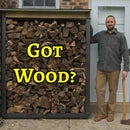Introduction: Half-Face-Cord Firewood Rack
A tree trimmer recently dropped off a load of maple logs that I'll be splitting into firewood. Before I get to work on that though, I need a firewood rack to store it in, so that's what I'm making here. I designed this rack to hold half of a face cord of firewood (4ft x 4ft x 16” deep) and be made using commonly available 4x4 lumber and fasteners from the home center. If you're interested in building one of these for yourself, I have a set of plans available.
If you enjoy this Instructable, be sure to subscribe to my YouTube channel for more!
Supplies
- (6) 4x4x6ft
- (4) Simpson Strong-Tie LPC4Z and fasteners
- deck screws
- 6" timber ties
Tools:
- miter saw
- impact driver
- hammer
- drill bits
- tape measure
Step 1: Cut Sleepers and Uprights to Length
Start off by measuring to length and cutting the Sleepers, which are the pieces that are at the bottom. My plans size these so that the opening of the rack is 4ft wide, but the rack can be expanded as desired to hold more firewood.
Next measure for and cut the uprights, which will keep the stack of firewood contained in the rack. These are 4ft tall. Though optional, I cut a 10-degree bevel at the tops of these for aesthetics and so that rain runs off more easily.
Step 2: Cut Spacers and Braces
The rack has two U-shaped frames formed by the sleepers and the uprights, and the frames are separated by spacer blocks. Measure and cut the six spacer blocks to length. I used a stop block so that I can make easily repeatable cuts without having to measure each one.
Next make the 45-degree braces for the bottom of the uprights. These are short braces that tuck into the corners of the frames and keep the uprights from bending outwards when the rack is loaded with firewood.
Step 3: Join Sleepers and Uprights With Braces
The braces are attached to the sleepers with a couple deck screws. The other end of the brace also attaches to the upright with deck screws. If things slip a bit, use a clamp to hold things in place.
Step 4: Add Post Cap Connectors at Bottoms of Uprights
On the inside face of the uprights, I use post cap connectors to hold the upright down to the sleeper. These have a slimmer profile than the 45-degree braces and take up less room where the wood goes. These can be fastened with either screws or nails per the manufacturer.
Make sure these are flush with the sleepers and the uprights when you drive the fasteners in.
Step 5: Measure for Spacer Placement, Chamfer Edges, Start Timber Ties
Next mark out where the spacers go on the assembled frames. This makes identifying where the timber ties go very easy.
This next step is optional, but I ran a 45-degree chamfer bit around the frames to soften the corners and make them less likely to splinter. Skip over the areas where the spacers go so you don't have a gap at the edges.
With that done, drive some 6" long timber ties part way into the frames at the locations of the spacers, in preparation of assembling the entire unit together. This will save having to hold the timber ties while hammering and while also trying to keep the unassembled frames stationary.
Step 6: Assemble Together
Clamp the two halves together to hold things in place, and drive the timber ties home. Repeat this for each spacer, clamping and flipping the rack around as necessary to access the timber ties.
At the end, you should have two U-shaped frames joined by the spacers, with the frames spaced at the perfect distance to hold standard lengths of firewood (14" to 16" length).
Step 7: Stage Rack in Place and Add Firewood
With the firewood rack assembled, I cleared out a space next to my chimney for it to sit. To provide for better airflow, and to help keep the sleepers from rotting out, I use some old bricks to prop it off the concrete. You'll want to maintain some space at the back of the rack so that air can circulate behind the firewood pile and speed drying. Keep the rack as level as possible front-to-rack for stability.
If you can, locate this rack somewhere that gets a lot of sun and wind exposure to speed up the drying process. Mine also happens to be located under an eave, so it will get less rain than it would being out in the open. You could add a roof to this rack, but I opted not to so that I could "overstack" the pile on top of the uprights.
All that's left to do is stack up some firewood on it, and wait for it to dry enough to burn!
If you enjoyed this Instructable, be sure to subscribe to my YouTube channel for more!






